Feb 18, 2009 | CCAC, coins, history, quarter
It is being reported that the Citizens Coinage Advisory Committee is considering changing the obverse of the America’s Beautiful National Parks Quarter Dollar Coins (Public Law Number 110-456 [GPO: Text or PDF]). My source pointed that that the law does not specify what is to be on the obverse of the coin only that the 1998 George Washington design. Rather than recommend a design with Washington on the reverse, the CCAC is considering honoring Theodore Roosevelt on the obverse.
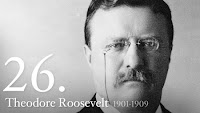 Theodore Roosevelt is credited with starting a modern renaissance of US coinage. When Roosevelt became president in 1901, he expressed his disdain for the sameness of the coinage designed by then chief engraver Charles E. Barber. Roosevelt want our coinage to reflect the greatness of the nation. He wanted a more modern classical design. Roosevelt enlisted the help of the greatest sculpture of the time, Augustus Saint Gaudens, to execute what Roosevelt called his “pet crime.”
Theodore Roosevelt is credited with starting a modern renaissance of US coinage. When Roosevelt became president in 1901, he expressed his disdain for the sameness of the coinage designed by then chief engraver Charles E. Barber. Roosevelt want our coinage to reflect the greatness of the nation. He wanted a more modern classical design. Roosevelt enlisted the help of the greatest sculpture of the time, Augustus Saint Gaudens, to execute what Roosevelt called his “pet crime.”
Duriung Roosevelt’s presidency, he was directly involved with the redesign of the gold coinage using the designs of Saint Gaudens on the eagle ($10) and double eagle ($20), Bela Lyon Pratt’s incuse design for the half-eagle ($5) and quarter eagle ($2.50) coins, and Victor David Brenner’s Lincoln Cent. The other Barber designs coin were retired by 1916.
In addition to Roosevelt’s influence on coinage, he was instrumental in growing the number of national parks and protected areas in the United States. Roosevelt, who spent a lot of time in the Badlands in the Dakota Territory influenced his view by setting aside 42 million acres of national forests, 53 national wildlife refuges, and other areas including the Grand Canyon.
Roosevelt started the program that lead to the National Wildlife Refuge system and established the US Forest Service to help maintain these natural resources.
To honor Theodore Roosevelt’s conservation work and preservation of many national parks and refuges and his “pet crime” for his redesign of US coinage, it would be fitting to honor him on the National Park Quarters. As a fan of our 28th president and his work, I have advocated that Theodore Roosevelt be honored on US coinage. If the CCAC follows through with this recommendation, it would make the National Parks Quaters more palatable.
Image of Theodore Roosevelt is from the White House website.
Feb 17, 2009 | coins, dollar, history
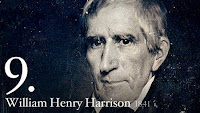 William Henry Harrison was elected the 9th President of the United States in 1840. A retired Major General of the United States Army, Harrison was famous for the Battle of Tippecanoe where he defeated the Shawnee Indians and lead by the brothers of Chief Tecumseh and Tenskwatawa The Prophet preserving the Indiana territory from further attack.
William Henry Harrison was elected the 9th President of the United States in 1840. A retired Major General of the United States Army, Harrison was famous for the Battle of Tippecanoe where he defeated the Shawnee Indians and lead by the brothers of Chief Tecumseh and Tenskwatawa The Prophet preserving the Indiana territory from further attack.
When Harrison won the Whig Party nomination for president, Harrison and his running mate, John Tyler adopted the campaign slogan, Tippecanoe and Tyler too to promote Harrison’s military record and reputation as a battle hero.
Harrison was inaugurated on very cold and wet day in Washington on March 4, 1841, without wearing an overcoat or hat in order to continue to show his toughness. His inaugural speech was the longest in American history, lasting nearly two hours. And this was the short version of the speech after it was edited by Daniel Webster for length.
President Harrison became ill with a cold on March 26 presumably as a result from the inauguration. The illness progressed to pneumonia, pleurisy and other symptoms not understood by the doctors of the period. Harrison died on April 4, 1841, after 32 days in office.
Harrison’s presidency and death was as historic as it was a test of the Constitution. Harrison was the oldest elected president at 68 until the election of Ronald Reagan in 1980. As the first president elected from the Whig Party, his two hour inaugural speech is the longest of any president and his term of 32 days is the shortest in United States history. Harrison was the only president to never appoint a federal judge.
Harrison was the first president to die in office. While we understand the rules of succession today, Harrison’s death caused a constitutional crisis in the young nation. The debate surrounded the interpretation of Article II of the Constitution:
In Case of the Removal of the President from Office, or of his Death, Resignation, or Inability to discharge the Powers and Duties of the said Office, the Same shall devolve on the Vice President, and the Congress may by Law provide for the Case of Removal, Death, Resignation or Inability, both of the President and Vice President, declaring what Officer shall then act as President, and such Officer shall act accordingly, until the Disability be removed, or a President shall be elected.
The vague wording caused a debate as to wether Vice President Tyler would take the oath of office as President or would he become an “acting president.” After debate in congress and by the cabinet, Chief Justice Roger Taney was consulted. Chief Justice Taney said that he thought the constitution meant for Tyler to take the oath of office as president. Based on Taney’s opinion, Tyler was given the oath on April 6, 1841.
As a historical note, Chief Justice Taney was presiding when the Supreme Court ruled on the infamous Dred Scott v. Sanford case in 1857.
This precedence was used in the transitions following the death of seven presidents. The 20th Amendment to the Constitution, ratified on January 23, 1933, codified the line of succession as well as change the inauguration date to noon on January 20th. Rules of succession was strengthened with the 25th Amendment that was ratified on February 10, 1967.
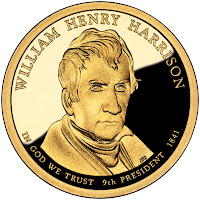 On February 16, the US Mint used 2009 President’s Day to pre-release the Harrison Dollar Coin to an audience in Charles City, Virginia. The coin officially goes into circulation on February 19. The reverse was designed and engraved by Mint Sculptor-Engraver Joseph Menna.
On February 16, the US Mint used 2009 President’s Day to pre-release the Harrison Dollar Coin to an audience in Charles City, Virginia. The coin officially goes into circulation on February 19. The reverse was designed and engraved by Mint Sculptor-Engraver Joseph Menna.
As Harrison was the cause of a number of firsts, the coin honoring his short presidency is the first of the Presidential Dollars to feature the motto In G-D We Trust on the obverse rather than the rim as mandated by law.
Image of William Henry Harrison from the White House website.
Image of the Harrison Dollar obverse courtesy of the US Mint.
Feb 3, 2009 | history, US Mint, video
On July 20, 1958, Mrs. Rae V. Biester, Superintendent of the US Mint in Philadelphia was a contestant on the the CBS game show, What’s My Line. Watch as Mrs. Biester stumps the pannel:
While looking for biographical information about Rae Biester, I was surprised to learn that she was instrumental in the promotion of proof coin sets in the 1950s.
According to Tom DeLorey in The Three Major Eras of Modern Proof Sets, following the passage of legislation that allowed the US Mint to produce proof sets in 1950, sales started slowly as the public was getting used to the program and paying a small premium over face value for the “special handling.” The newly appointed Biester did what she could to help increase sales of proof sets, especially during a recession, in order to prevent layoffs. DeLorey writes:
Sales increased slowly over the first few years, and finally began to climb in 1954 under the personal care and promotion of the new Philadelphia Mint Superintendent Rae Biester, who sought to avoid a threatened round of layoffs by increasing Mint output via Proofs. Biester went so far as to write personal notes thanking buyers of the 1953 Proof sets, and inviting them and their friends to buy the 1954 and subsequent sets.
Under Biester’s administration the packaging was improved by placing the coins between two sheets of plastic divided into pockets via a simple pressure bonding, which allowed the coins to be viewed and displayed without removing them from their original holders. These &ldlquo;flat packs” appeared in mid-1955, and this is the only year which is collected by holder variations (other than by product variations).
By the time Mrs. Biester appeared on What’s My Line, she had saved the proof program and protected the employment of many US Mint employees.
Feb 2, 2009 | coins, history, state quarters
After I posted a review of the DC quarter, I remembered that I had not posted what I consider the 10 State Quarter designs that best represents history and teaches us something about the state and our nation. These quarters may not be the best designs, but they represent a unique story about the state that makes it unique and contributes to the nation. Every one of the designs told a story of accomplishment and a proud heritage for the state it represents. I also learned something after each of these quarters were released.
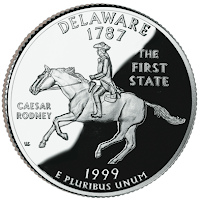 #1 Delaware
#1 Delaware
Engraver: William Cousins
On the very first coin, I learned who Caesar Rodney was and why is he riding a horse on the back of the Delaware quarter. Rodney was one of Delaware’s representative to the Continental Congress. He was in Dover attending to other business when he learned that Thomas McKean and George Read were deadlocked on the vote of independence. Rodney rode 80 miles from Dover to Philadelphia to vote with McKean to allow Delaware join eleven other colonies voting in favor of independence. Rodney’s signature appears on the document representing Delaware and on the Declaration of Independence. Now that’s history!
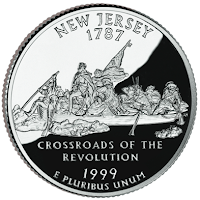 #2 New Jersey
#2 New Jersey
Engraver: Alfred Maletsky
We learned in our history classes that General George Washington lead the revolutionary troops across the Delaware River in the middle of the night to surprise the English at the Battle of Trenton on December 26, 1776. In addition to George Washington, future presidents James Madison and James Monroe was part of the contingent. Rivals Alexander Hamilton and Aaron Burr along with future Chief Justice of the Supreme Court John Marshall were soldiers serving under Gen. Washington. The Battle of Trenton was a key battle that helped change the outcome of the war for independence.
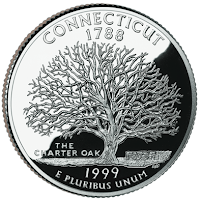 #3 Connecticut
#3 Connecticut
Engraver: T. James Ferrell
Although the Charter Oak appeared on the reverse of the 1935 Connecticut Tercentenary Commemorative Half Dollar, younger collectors probably have not seen the coin. Adding it to the Connecticut state quarter had me looking up the history of this tree. It was said that the colony’s charter was hidden in a cavity within the tree when James II sent a new governor to Connecticut to reclaim the document. One of the first “battles’ against the authority of the British monarchy.
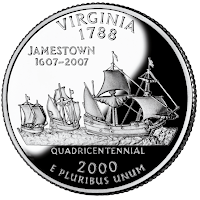 #4 Virginia
#4 Virginia
Engraver: Edgar Z. Steever
Jamestown, Virginia was the first permanent European settlement in the New World and would celebrate its quadricentennial in 2007. The design features the three ships that brought the first settlers to the new colony: Susan Constant, Godspeed, and Discovery. We are reminded of the beginning of this nation and how they came to the new land. Having visited Jamestown, I thought the design was exciting.
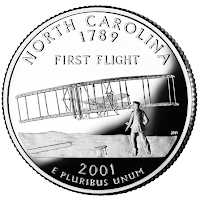 #5 North Carolina
#5 North Carolina
Engraver: Don Everhart
On a cold, wind swept day on December 17, 1903, Orville and Wilbur Wright made the first powered, controlled, sustained airplane flight from the sands outside of Kitty Hawk, North Carolina—now the town of Kill Devil Hills. For three years, the Wright brothers lived in Kitty Hawk testing and perfecting their design that culminated in four successful flights on December 17. We may take flying for granted today, but this one event significantly changed history.
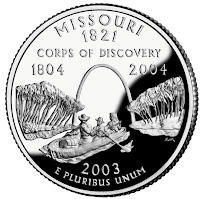 #6 Missouri
#6 Missouri
Engraver: John Mercanti
The Corps of Discovery headed by Meriwether Lewis and William Clark that explored the Louisiana Purchase was an significant event that lead to the country’s western expansion across the continent. The trip ended in what is Oregon today. Amongst his party was his Indian guide Sacagawea and her baby Jean-Baptiste Charbonneau. The design shows Lewis and Clark’s return to St. Louis from their venture.
 #7 Iowa
#7 Iowa
Engraver: John Mercanti
It would have been easier for Iowa to create a quarter design based on its agricultural heritage. Instead, they chose to celebrate their education values demonstrated in their history. Basing the design on Grant Wood’s “Arbor Day,” the quarter shows a one-room school house with a teacher helping students plant a tree. When you learn that Iowa was one of the first states to organize their schools in county-based districts. Along with being amongst the first to form high schools, their experiences were adopted in other states. A subtle, yet important, historical note.
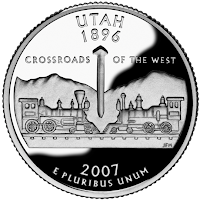 #8 Utah
#8 Utah
Engraver: Joseph Menna
On May 10, 1869, the Union Pacific and Central Pacific railroads officially completed the first transcontinental railroad. The completion was celebrated at Promontory Summit, Utah with the driving of the Golden Spike. Although there was one segment in California that was completed later, the transcontinental railroad provided significant economic development for the newly expanded areas of the country.
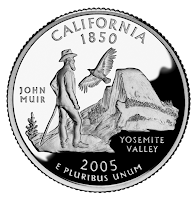 #9 California
#9 California
Engraver: Don Everhart
When Governor Arnold Schwarzenegger announced that the design for the California quarter would honor John Muir, I had to go beyond my basic education as the who Muir was. I knew Muir was a naturalist and the founder of the Sierra Club. What I did not know was that Muir was instrumental in saving Yosemite Valley and Sequoia National Park. I also learned that Muir was widely published about ecology and proposed ecological programs that began to gain favor in the 1970s, more than 60 years following his death. Although he generated a lot of controversy, his concepts show benefits today. For teaching me about Muir, California’s quarter makes this list.
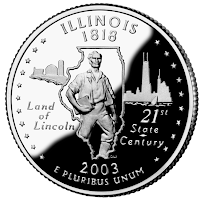 #10 Illinois
#10 Illinois
Engraver: Donna Weaver
Anyone who was educated in the United States knows the basic story of Abraham Lincoln. We know that he was the 16th president and issued the Emancipation Proclamation. We know he was the president throughout the Civil War and delivered the most remembered speech at Gettysburg, Pennsylvania. Lincoln was born in a log cabin in Kentucky and was assassinated at Ford’s Theater in Washington, DC. But I learned that Lincoln interested in the river and railroads. He holds a patent related to the buoying of vessels. I knew that he was the first Republican elected president but I did not know he was one of the party’s founders. There is so much more fascinating information that I learned about Lincoln that was never taught in school, but this is supposed to be a short paragraph. You should read some of the books about Lincoln. He is a fascinating person and what he did as president is the reason why he is considered our greatest president.
Jan 20, 2009 | history, legal, US Mint
A few moments ago, on the west side of the Capitol, Barack Obama was sworn in as the 44th President of the United States. On a specially built platform, President Obama put his hand on the same bible that Abraham Lincoln used at is inauguration in 1861 and was sworn in by John Roberts, Chief Justice of the Supreme Court. Millions millions of people watching on the National Mall and around the world heard President Obama take the oath of office:
I Barack Hussein Obama do solemnly swear that I will faithfully execute the Office of President of the United States, and will to the best of my Ability, preserve, protect and defend the Constitution of the United States. So help me G-D.
Whether you voted for President Obama or not, this is a historical moment that everyone should savor. We wish the new president well and hope he will pursue the right policies to better this country.
Numismatically, President Obama’s election has caused opportunists to come out of the woodwork with numismatic collectibles that potential collectors should think twice about before purchasing. We have seen the advertisements on television, in magazines, and as fliers in other mail. They are advertised as “exclusive” and “limited editions” with prices set at one price, but if act today, you can receive the coins at a lower price.
If you buy these coins, please remember that these vendors are colorizing business strikes made by the US Mint and are worth their face value. Coins are colorized or thinly plated with less with less than a few cents of gold. Although the work is made with real coins, they are numismatically worthless. Similar collectibles for other events have not increased in value. In some cases they worth less than their issue price.
The US Mint warns that the coins are not official US Mint products and not endorsed by the Mint.
Please enjoy the view of history from where ever you are. But please consider another collectible to honor this history. Pins, buttons, clothing, hats, copies of The Washington Post from the day of the inauguration are wonderful alternatives that you can appreciate for years to come.
Dec 25, 2008 | history, other
Those of us who normally do not celebrate a holiday on December 25 was able to celebrate the lighting of the fifth Chanukah candle. For those who do not know the story of Chanukah: after the Maccabees drove the Greeks from Holy Land, the people went to clean up and rededicate the Second Temple in Jerusalem. When they went to light the menorah, they found a one-day supply of olive oil that was not contaminated. Knowing that it would take a week to manufacture more olive oil, the people lit the menorah for the dedication. That one-day supply of oil kept the menorah lit for eight days. Chanukah is the celebration of that miracle.
A tradition that came out this era was the play with the dreidle. A dreidle is a four-sided top with the Hebrew letters of the phrase (transliterated) &ldquot;nes gadol hayah sham” which means “a great miracle happened there.” In Israel, the last word is replaced with “po” meaning “here.” To play, players start with an ante and one person spins the dreidle. Depending on which letter the dreidle lands is what the spinner does. Using the order of the Hebrew phrase, the moves are (Nun) to give or get nothing, (Gimel) get everything in the pot, (Hey) get half of what is in the pot, and (Shin or Peh) means to pay into the pot. Yes, it’s a gambling game.
 While anything can be used to play dreidle, it is traditional for parents to give children Chanukah gelt to play. Although we think of gelt as money, it can take any form of exchange. One of my favorite types of gelt is chocolate gelt. Little disks of chocolate that resembles the coin of the relm.
While anything can be used to play dreidle, it is traditional for parents to give children Chanukah gelt to play. Although we think of gelt as money, it can take any form of exchange. One of my favorite types of gelt is chocolate gelt. Little disks of chocolate that resembles the coin of the relm.
My wife indulged my passion for gelt by giving me chocolate gelt and a few gift cards. I had found other gold foil-covered disks that look like quarters and halves, but her choice of chocolate was better than mine. Now I have to go find someone to play dreidle—one can never have enough chocolate!
Regardless of what you celebrate, may you find happiness and peace in your celebration and a hope that 2009 is better than 2008!
Dec 4, 2008 | errors, history, medals
The University of Georgia is the nation’s oldest land grant university. The Georgia legislature approved the land grant measure in 1784 and the college was chartered in 1785. The first Board of Trustees meeting was held in 1786 and elected Abraham Baldwin as the college’s first president. Baldwin, originally from Connecticut, was a Yale graduate who moved to Georgia in 1784 and was asked to help draft the school’s original charter.
When the Board of Trustees decided to open the university in 1801, they selected a site. John Milledge purchased 633 acres of land in northeast Georgia and donated it to the Board of Trustees. Part of the land was developed into the town of Athens, the rest is still owned by the University.
Josiah Meigs was named president in 1801 and the Board of Trustees named the first college Franklin College in honor of Benjamin Franklin. Although the charter named the school the University of Georgia, it was known as Franklin College until 1859 when the College of Agriculture and Environmental Sciences was founded. Meigs held the first classes under a tree on what is now called North Campus. While classes were held, log buildings were hastily built as temporary structures until permanent buildings would be built.
The first permanent building was modeled after Connecticut Hall at Yale University. When it was completed in 1805, it housed classrooms, administrative offices, and dormitories. Today, that building is called Old College. Since the 1950s, it has been used as the administrative offices for the Franklin College of Arts and Sciences.
 One evening, I was searching a popular online auction site looking for something to add to my American Revolution Bicentennial collection. While searching, I found this medal for the bicentennial of my undergraduate Alma Mater (see image on right). As an alumnus of the University of Georgia, I had to buy this medal.
One evening, I was searching a popular online auction site looking for something to add to my American Revolution Bicentennial collection. While searching, I found this medal for the bicentennial of my undergraduate Alma Mater (see image on right). As an alumnus of the University of Georgia, I had to buy this medal.
Other than the subject, the medal had an interesting because of an error: the lettering on the reverse is doubled (click image to enlarge). It looks as if the dies were punched then repunched with new spacing in the lettering. While it was described in the auction listing, I had to see the medal in hand to try to understand how this error occurred. Even in-hand, it is difficult to tell. It looks as if the dies were re-punched after the letters were reset—as if someone did not like the layout and tried to change it after the dies were created.
What was not described in the auction listing was the doubling I found on the obverse. The error was very subtle and would not have been noticed by someone who was not familiar with the University of Georgia. While examining the medal, I noted that the school’s motto is on the tree’s trunk: Et docere et rerum exquirere causas (To teach, to serve, and to inquire into the nature of things).
Looking just above the motto, I saw that the “200” was doubled and above that, “To Inquire,” was also doubled. Curiosity brought out my loupe and examined the branches for the other two parts of the motto and found “To Teach” above the lower-left branch of the tree and “To Serve” above the lower-right branch. All are doubled! These are clearly re-punched into the dies.
Aside from the subject, the “errors” are fascinating. It is like getting two collectibles in one medal.
HOW BOUT THEM DAWGS!
Nov 27, 2008 | history, other
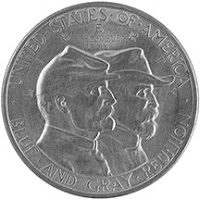
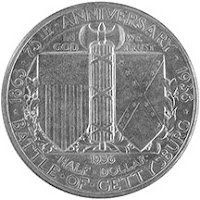 Thanksgiving was first celebrated in 1621 by the settlers at Plymouth, Massachusetts. George Washington was the first to issue a proclamation honoring Thanksgiving during his presidency. The only other president to issue a Thanksgiving proclamation was James Madison. It was Abraham Lincoln who issued a proclamation that made Thanksgiving Day a national annual event. Ironically, the first national observance of Thanksgiving under this proclamation came a week after the dedication of the Soldiers National Cemetery at Gettysburg.
Thanksgiving was first celebrated in 1621 by the settlers at Plymouth, Massachusetts. George Washington was the first to issue a proclamation honoring Thanksgiving during his presidency. The only other president to issue a Thanksgiving proclamation was James Madison. It was Abraham Lincoln who issued a proclamation that made Thanksgiving Day a national annual event. Ironically, the first national observance of Thanksgiving under this proclamation came a week after the dedication of the Soldiers National Cemetery at Gettysburg.
Be thankful for your life.
Be thankful for your family.
Be thankful for our hobby.
Be thankful for everything.
Happy Thanksgiving!
Image of 1936 Gettysburg Commemorative Half Dollar courtesy of the US Mint.
Nov 12, 2008 | dollar, history, US Mint
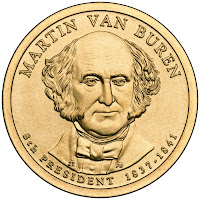 On November 13, the US Mint will release the Martin Van Buren Dollar to honor our eighth president. Van Buren was one of the founders of the modern day Democratic Party. He succeeded Andrew Jackson after serving as Jackson’s vice president.
On November 13, the US Mint will release the Martin Van Buren Dollar to honor our eighth president. Van Buren was one of the founders of the modern day Democratic Party. He succeeded Andrew Jackson after serving as Jackson’s vice president.
Van Buren’s presidency was not considered a success after the Panic of 1837 that was caused by Jackson’s refusing to renew the charter of the Second Bank of the United States and withdrew federal funds from then bank. The result was a credit crisis when banks could not access funds and purchase securities to back their deposits.
Van Buren spent the rest of his presidency trying to fix the economy while trying to stay true to Jacksonian Democratic policies, which was not well received. Van Buren refused to expand the treasury, renew the charter for the Bank of the United States. And with slavery being an issue, Van Buren blocked statehood for Texas to prevent the expansion of slave owning states.
Van Buren served one term when he was defeated by the Whig Party candidate William Henry Harrison in 1840.
Image courtesy of the US Mint.
Nov 11, 2008 | history, RCM
On the eleventh hour of the eleventh day of the eleventh month in 1918, the war to end all wars ended. It is celebrated around the world as Armistice Day or Remembrance Sunday. In the United States, a law was passed in 1954 to honor all veterans on November 11 of every year.
There will be the usual celebrations around the nation. Ceremonies will be held at Arlington National Cemetery that will culminate with the laying of a wreath at Tomb of the Unknowns
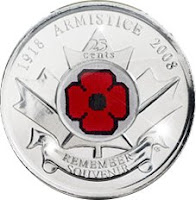 In Canada, the Royal Canadian Mint has reissued the Poppy Circulating Quarter to honor the 90th anniversary of the end of World War I. The poppy became popular in Canada when mentioned in a poem by Canadian Medical Director John McRae in the lime-rich fields of Belgium.
In Canada, the Royal Canadian Mint has reissued the Poppy Circulating Quarter to honor the 90th anniversary of the end of World War I. The poppy became popular in Canada when mentioned in a poem by Canadian Medical Director John McRae in the lime-rich fields of Belgium.
RCM has been distributing these quarters through retail outlets throughout the country along with providing special collectibles on their website. One dollar from the sale of each 2008 Limited Edition Poppy Bookmark will be donated to the Legion’s Dominion Command Poppy Trust Fund, which provides financial aid to Canada’s veterans.
To the veterans of the War to End All Wars and every wars since, thank you for your service to our country!
Image courtesy of the Royal Canadian Mint.
 Theodore Roosevelt is credited with starting a modern renaissance of US coinage. When Roosevelt became president in 1901, he expressed his disdain for the sameness of the coinage designed by then chief engraver Charles E. Barber. Roosevelt want our coinage to reflect the greatness of the nation. He wanted a more modern classical design. Roosevelt enlisted the help of the greatest sculpture of the time, Augustus Saint Gaudens, to execute what Roosevelt called his “pet crime.”
Theodore Roosevelt is credited with starting a modern renaissance of US coinage. When Roosevelt became president in 1901, he expressed his disdain for the sameness of the coinage designed by then chief engraver Charles E. Barber. Roosevelt want our coinage to reflect the greatness of the nation. He wanted a more modern classical design. Roosevelt enlisted the help of the greatest sculpture of the time, Augustus Saint Gaudens, to execute what Roosevelt called his “pet crime.”

















